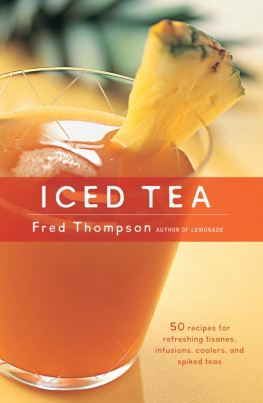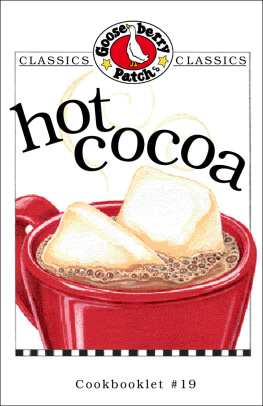The Harvard Common Press
535 Albany Street
Boston, Massachusetts 02118
www.harvardcommonpress.com
Copyright 2006 by Fred Thompson
Photographs copyright 2006 by Brian Hagiwara
All rights reserved. No part of this publication may be reproduced or transmitted in any form
or by any means, electronic or mechanical, including photocopying, recording, or any infor
mation storage or retrieval system, without permission in writing from the publisher.
Printed in China
Printed on acid-free paper
Library of Congress Cataloging-in-Publication Data
Thompson, Fred, 1953
Hot Chocolate : 50 heavenly cups of comfort / Fred Thompson.
p. cm.
Includes index.
ISBN 1-55832-290-6 (hardcover : alk. paper)
1. Chocolate drinks. I. Title.
TX817.C4T56 2006
641.8'75dc22
2006002865
ISBN-13: 978-1-55832-290-5
Special bulk-order discounts are available on this and other Harvard Common Press books.
Companies and organizations may purchase books for premiums or resale, or may arrange a
custom edition, by contacting the Marketing Director at the address above.
Book design by Elizabeth Van Itallie
Photographs by Brian Hagiwara
Food styling by Fred Thompson
10 9 8 7 6 5 4
In memory of Al Haskins, Jr.,
who consumed chocolate almost every day
of his 92 years
Acknowledgments
Being in the right place, at the right time, with the right folks, sure can pay off. While at a conference in the Napa Valley, Suzanne Hamlin and Janet Fletcher, both well-known food writers, complimented me on my cookbooks Iced Tea and Lemonade and wondered what I was going to do next. While I stumbled for an answer, they simultaneously suggested that I write one on hot chocolate. Thus a book was born. Now my "liquid" trilogy is complete.
The staff at Scharffen Berger Chocolates in Berkeley, California, who showed me how chocolate is made and fielded a bunch of questions, deserve a thank-you. They made writing this book a joy.
A big thanks to Bruce Shaw and his great staff at The Harvard Common Press: executive editor Valerie Cimino, creative services manager Virginia Downes, managing editor Christine Corcoran Cox, project manager Patricia Jalbert-Levine, production editor Abby Collier, associate publisher Christine Alaimo, sales director Betsy Young, publicity manager Liza Beth, special sales associate Megan Weireter, marketing assistant Amy Etcheson, and office manager Ellie Levine. Thanks also go to Jayne Yaffe Kemp, a super copyeditor.
Brian Hagiwara, as usual, makes the photographs jump from the page. They will make you want to run and try one of my hot chocolates. His talents are much appreciated. Nikki Parrish was there with all manner of word-processing help and was always willing to test a recipe. My neighbors the Johnsons and the Thomases drank many a cup of hot chocolate, both good and bad. And Belinda Ellis, who was full of ideas, taught me how to make marshmallows. You'll meet other people in the pages of this book who shared ideas and recipes with me.
I've had much help and encouragement in my writing career. Folks like Susan Houston, my editor at the Raleigh News & Observer; Toni Allegra and Don Fry from the Greenbrier Symposium for Professional Food Writers; and Pam Hoenig all have had an impact on the way I view food and writing.
A special thanks to Laura, who has always thought it was cool that her dad writes cookbooks.
Introduction
Hot chocolate is winter's gift to our soul. Nothing completes a roaring fire better than a cup of hot chocolate and someone to snuggle with. And more and more, hot chocolate is becoming the beverage of choice for a morning eye-opener, a midmorning pick-me-up, or an afternoon stress reliever. No longer is this elixir just the domain of childrenit truly has taken its place in the adult world.
My earliest memory of hot chocolate was the cup that my dad would buy for me at ice hockey games when I was in middle school. I thought I was pretty cocky walking around with a hot beverage. It seemed so grown-up at the time, and it started a love affair with hot chocolate that has lasted for many years. Of course, that concession-stand hot chocolate was pumped out of a machine and looked more antique white than coffee with cream. Back then, almost all "hot chocolate" was really hot cocoa. In those days that's all I knew: a little chocolate flavor with a lot of hot milk.
Fast-forward to a few years ago, when I had my first taste of a European-style hot chocolate made with bar chocolate, not cocoa powder. The taste was revolutionary: serious chocolate flavor with just a touch of milk or cream. That cup launched a worldwide search for hot chocolate. Trips across the country, south of the border, and to Italy and France, along with the cultural mix in New York City, where I live, have introduced me to some extraordinary ways with hot chocolate. I'd like to share the best of those with you.
THE BASICS
A Quick History of Hot Chocolate
Chocolate has been drunk for thousands of years, most archaeologists agree, but it was the Mayans who really got the ball rolling by developing savory chocolate drinks. They also used cocoa beans as currency. In the 1500s the Aztecs introduced a little sweetness to the mixture in the form of honey. The explorer Hernando Corts brought chocolate back to Spain from his explorations in the New World. He also learned from the Mexican emperor Montezuma that chocolate has aphrodisiac properties. The Spaniards blended sugar with their hot chocolate, and it soon became the drink of the rich elite. And if you think the coffeehouse craze is a new concept, you may be surprised to learn that London had "chocolate houses" in the 1700s, and they were quite the rage. Writers, politicos, and socialites alike would gather at these spots to hash out the events of the day. The English have the distinction of being the first to blend milk into chocolate, at the beginning of the 1700s.
In 1764, in what is now the city of Dorchester, Massachusetts, the first American chocolate manufacturer opened its doors. The company was called, as it is today, Baker's Chocolate. As the Industrial Revolution continued, the Dutch developed a chocolate press, and that, coupled with a drop in sugar prices, allowed the masses to enjoy chocolate. The Europeans continued their stronghold on chocolate making until the early twentieth century, when a successful caramel maker, Milton Hershey, decided that chocolate was the future. "Caramels are a fad, but chocolate is a permanent thing," he is believed to have said. Well, caramel wasn't a fad, but he was right about chocolateit is a permanent part of the world's culture. While Hershey has been the dominant chocolate maker in the United States, other, smaller companies are quickly expanding America's taste for more upscale and cacao-loaded pleasures.
Thomas Jefferson predicted that chocolate would overtake tea and coffee as the most popular drink in America. He might have been off on the drinking part, but chocolate in one form or another has become a staple of our everyday life.
Today, chocolate styles vary greatly from country to country. French and Belgian chocolate makers look down their noses at the British and Americans for the inclusion of milk in chocolate bars. They prefer the flavors of bittersweet or semisweet or even unsweetened chocolate to the milk chocolate that so many of us have grown up with in America. But our exposure is changing. More and more, high-quality chocolates are being imported into the United States, and chocolate makers and bakers alike continue to introduce us to new flavor concepts. We also are very fortunate in this country to have a chocolate maker like Scharffen Berger in Berkeley, California, which has brought high-end, exceptionally delicious European-style chocolate to our shores.
Next page












